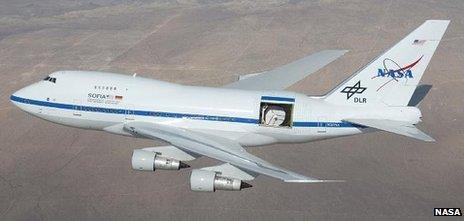Sofia flying observatory shares its unique cosmic view
- Published

The 747 has been significantly modified to house the 15-tonne telescope
An enormous telescope mounted in the back of a converted 747 jet has come up with a bounty of data taken on the fly.
The Stratospheric Observatory for Infrared Astronomy, or Sofia, made 35 flights in the past year, shedding light on the far-flung Orion Nebula and our relatively near neighbour Pluto.
The observatory can "see" in wavelengths of light that no Earth or space-based telescope can detect.
The results were presented at the 219th American Astronomical Society meeting, external.
The 15-tonne telescope is mounted in a swivelling mount so it can remain fixed on the stars as it flies through the night on hours-long missions.
It is designed in particular to peek at the cosmos in the infrared portion of the electromagnetic spectrum, one that Earth-bound telescopes cannot see because water vapour in the atmosphere absorbs the incoming infrared light.
Among the telescope's high-profile targets was the Orion nebula, and the team released its first pictures from the Orion flights, external in late December.

Analyses of the Orion Nebula's heart show never-before-seen emission sources
Now, James De Buizer of the Universities Space Research Association (USRA) has taken a close look at those data and found a surprise that has eluded astronomers for decades.
Dr De Buizer and his colleagues focused on a region of the nebula around the Becklin-Neugebauer or BN object, which cannot be seen in visible wavelengths but is one of the brightest objects in the sky in the infrared.
"This part of the Orion Nebula this part has been observed for decades - it's the closest area of star formation in the galaxy, so it gives us the best glimpse into how stars form," Dr De Buizer told BBC News.
He explained that the BN object had long been held to be the dominant source of emission from the nebula. However, thanks to the vision of Sofia's Forcast instrument, it has become clear that something else is shining bright in the region, deep in the infrared, which he believes is a small "protocluster" of stars.
"Understanding that was completely facilitated by being able to observe at these long wavelengths and at these resolutions we're achieving," he said.
On the move
But Sofia's telescope can also use the Hipo instrument to see visible light, making good use of the facility's mobile nature. Further data are coming from Sofia's Pluto occultation mission, carried out in June, external.
Just as with a solar eclipse, Pluto can pass in front of a distant star, yielding details of its size and atmosphere as it does.
Ted Dunham of the Lowell Observatory and his team were able to find the exact spot on the Earth to see this total eclipse of Pluto, thanks to real-time calculations of the path of the "shadow" delivered by collaborators on the ground. (Sofia's airborne predecessor, the Kuiper Airborne Observatory, discovered the rings of Uranus in a similar way, external 35 years ago.)
Perhaps most intriguing is the discovery, for the first time, of a simple molecule of one atom each of hydrogen and sulphur in interstellar space.
David Neufeld and his team used Sofia's Great device to gain a unique look into exotic chemistry that is hard to replicate in labs on Earth.
The discovery of such molecules will go a long way to explain how the more complex molecules we see across the cosmos are built up.
Helen Hall, associate director for project management for USRA, told BBC News that it "had been a good year".
"We had over 30 flights of science. It took 12 years to get to this spot, and we have a really good team that we've put together. We demonstrated the telescope, the instruments and the team, a team that now has a routine down on how you do an airborne science mission."
The next year should hold more science and more surprises. Sofia works as a user facility, meaning scientists can propose experiments and get time up in the air to pursue them.
Erick Young, director of science mission operations for Sofia, explained that a new call is out for the next year of missions, and he has high hopes.
"Time on Sofia is open to the whole community - whatever kind of interesting proposals they can come up with is the only thing that's going to limit Sofia, and there's a pretty innovative group of astronomers out there in the world."
- Published17 January 2011